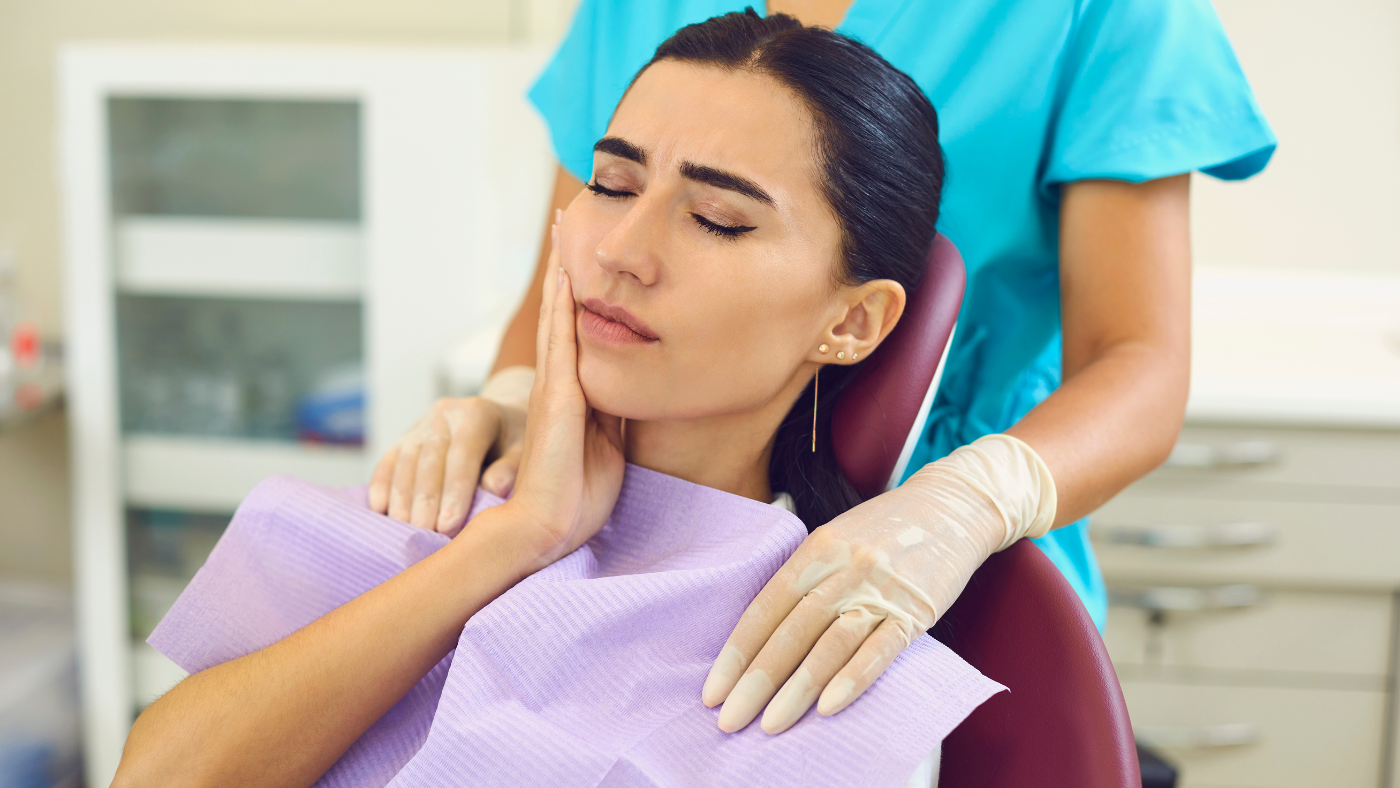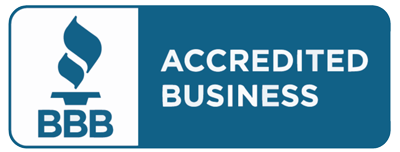As Ohio dental practices continue to innovate patient care, dental medication compounding continues to grow — playing a larger role in enhancing patient comfort, improving outcomes, and addressing unique oral health challenges.
The Role of Pharmacist Collaboration in Dental Care
Pharmacists play a crucial behind-the-scenes role in dental care by identifying challenges and proposing solutions that dentists may not be aware of.
Compounding pharmacists collaborate with dental professionals in developing customized formulations that target challenging conditions such as temporomandibular joint (TMJ) disorders, periodontal disease, oral infections, procedural anxiety, and mucosal irritation.
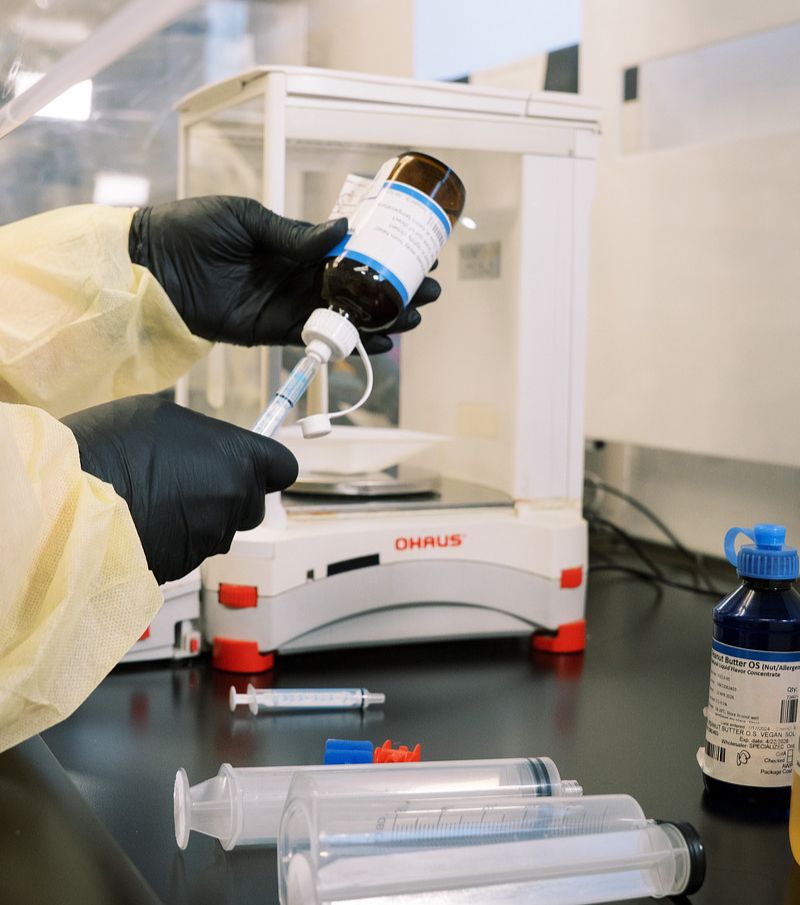
As Ohio dental practices continue to innovate patient care, dental compounding continues to grow — playing a larger role in enhancing patient comfort, improving outcomes, and addressing unique oral health challenges.
The Role of Pharmacist Collaboration in Dental Care
Pharmacists play a crucial behind-the-scenes role in dental care by identifying challenges and proposing solutions that dentists may not be aware of.
Compounding pharmacists collaborate with dental professionals in developing customized formulations that target challenging conditions such as temporomandibular joint (TMJ) disorders, periodontal disease, oral infections, procedural anxiety, and mucosal irritation.

Oral Conditions and How Dental Compounding May Help
Let’s explore the most common ways dental professionals work hand-in-hand with Central Ohio Compounding Pharmacy to provide an extraordinary experience for patients.
TMJ Pain Management
Temporomandibular joint disorder (TMJ) often causes chronic jaw pain, muscle spasms, and inflammation. Compounded topical formulations help deliver targeted relief directly to the affected area without the systemic effects of oral medications.
Commonly compounded Active Pharmaceutical Ingredients (APIs) for TMJ include:
- Ketoprofen and Cyclobenzaprine: Anti-inflammatory and muscle relaxant combination to help reduce joint and muscular pain.
- Lidocaine and Bupivacaine: Local anesthetics used to help numb pain in the joint and surrounding tissue.
- Potassium-based gels: Used for nerve desensitization in cases with heightened oral nerve sensitivity.
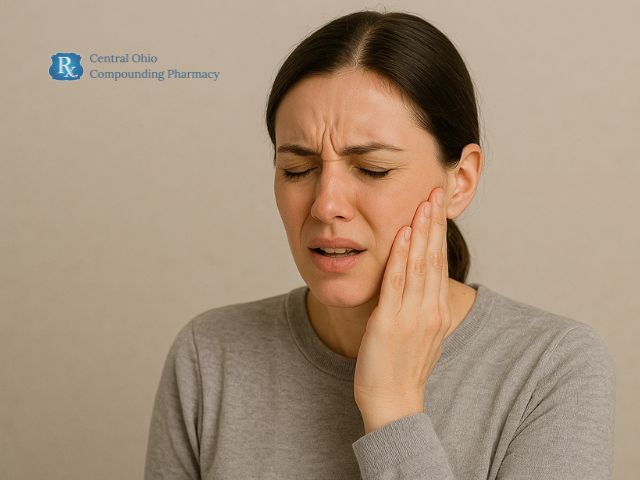
Commonly compounded Active Pharmaceutical Ingredients (APIs) for TMJ include:
- Ketoprofen and Cyclobenzaprine: Anti-inflammatory and muscle relaxant combination to help reduce joint and muscular pain.
- Lidocaine and Bupivacaine: Local anesthetics used to help numb pain in the joint and surrounding tissue.
- Potassium-based gels: Used for nerve desensitization in cases with heightened oral nerve sensitivity.

Example: An Ohio dental group began referring patients with TMJ pain for a compounded topical containing cyclobenzaprine, ketoprofen, and lidocaine in a transdermal base. This approach was selected to minimize systemic side effects. After one month of consistent use, the dentist reports reduced reports of jaw clenching pain and fewer muscle spasm-related complaints. The patient also appreciates avoiding oral muscle relaxants due to prior drowsiness issues.
Periodontal Disease and Oral Infections
Periodontal infections require potent, localized antimicrobial therapy. Compounded gels and pastes are used to address gum disease, periodontal pockets, and oral mucosal infections.
- Metronidazole, Minocycline, and Ciprofloxacin: Antibacterial agents used alone or in combination to reduce biofilm and address deep gum infections.
- Hydrogen Peroxide Oral Gel: Oxygenating agent that helps reduce bacterial load and supports gum healing.
- Amphotericin B: Antifungal troches and rinses used for oral candidiasis (thrush), particularly in immunocompromised patients.
- Chlorhexidine Rinses: Antimicrobial solutions to prevent or address gingivitis, halitosis, and after-procedural infections.
Oral Pain, Ulcers, and Mucosal Conditions
Patients undergoing dental procedures or experiencing mucosal conditions often need relief from pain, ulcers, or irritation.
- Magic Mouthwash: Typically includes lidocaine, diphenhydramine, antacid, and other soothing agents for mucositis.
- Tetracycline, Nystatin, Diphenhydramine, and Hydrocortisone: Prescribed for mouth ulcers and managing combined bacterial/fungal infections.
- Misoprostol Oral Rinse: Protects mucosal lining and promotes healing.
A commonly overlooked factor in mouthwash efficacy is viscosity. By adjusting the thickness of oral rinses, compounding pharmacists improve how long medications stay in contact with the mucosal tissue. This is especially useful for managing conditions like mucositis or mouth ulcers, where prolonged exposure increases therapeutic effect.
Insider Tip: Compounding pharmacists often use permeation enhancers like Pluronic Lecithin Organogel (PLO gel) for buccal or intraoral application to increase drug delivery through the mucosa — something not found in commercial dental products.
PLO gel is a transdermal delivery vehicle commonly used in compounding to help medications penetrate the skin or mucosal tissues effectively.
Oral Inflammatory Disorders
Conditions like oral lichen planus require both anti-inflammatory and mucosal-protective therapies.
- Tretinoin and Clobetasol Propionate: Combined in rinses, pastes, or troches to address inflammation, reduce lesion formation, and promote mucosal healing.
- Triamcinolone: Used in oral adhesive pastes and rinses to manage inflammation and promote healing of lesions.
Angular Cheilitis and Localized Infections
Angular cheilitis and similar localized infections may benefit from antifungal, anti-inflammatory, and natural agents.
- Miconazole or Clotrimazole, combined with Ibuprofen and Tea Tree Oil: Addresses fungal and bacterial infections at the corners of the mouth.
Dry Mouth and Burning Mouth Syndrome
These conditions can severely affect quality of life and oral health. Compounded therapies aim to restore moisture, protect mucosa, and reduce nerve hypersensitivity.
- Pilocarpine Troches or Sprays: Stimulate salivary flow in patients with xerostomia (dry mouth).
- Electrolyte-Based Rinses or Troches: Provide hydration and restore mucosal barrier function.
- Capsaicin, Amitriptyline, and Gabapentin: Used in mouth rinses or troches to manage burning mouth syndrome through nerve modulation.
Gag Reflex and Procedural Anesthesia
Managing gag reflexes and providing effective anesthesia are critical to ensuring comfort during procedures.
- Dyclonine Oral Solutions or Gels: Non-caine anesthetic used to suppress gag reflex.
- Tetracaine Lollipops and Anesthetic Gels: Used for pre-procedural numbing to reduce discomfort and anxiety.
- Multi-agent Anesthetic Gels: Include lidocaine, tetracaine, phenylephrine, and prilocaine for strong topical numbing.
Example: While dentists commonly use oral sedatives, some patients are sensitive to them or refuse sedation. Compounded transdermal anxiety creams or sublingual troches containing gabapentin, clonidine, and diphenhydramine may help alleviate mild to moderate procedural anxiety without full sedation. These are especially helpful in pediatric or geriatric populations.
Post-Extraction and Dry Socket Care
After extractions, patients may experience dry socket or ongoing pain. Compounded medications support healing and pain relief.
- Benzocaine Pastes and Dressings: Provide localized pain relief and protect the socket.
- Lidocaine and Eugenol Combinations: Offer extended pain control and antimicrobial effects.
Example: An Ohio dentist refers a patient experiencing recurring dry socket pain despite standard care. Our compounding pharmacist recommends a dressing paste containing benzocaine, eugenol, and a mild steroid. The patient reports rapid symptom improvement and avoids further interventions. The paste’s custom viscosity allows it to remain in place longer than OTC options, enhancing patient outcomes and satisfaction.
Root Canal Procedures
Cleaning and disinfecting root canals may be enhanced with compounded antimicrobial agents.
- EDTA and Carbamide Peroxide Solutions: Break down debris and disinfect the canal space.
- Nitrofurazone and Sulfadiazine Sodium Solutions: Deliver targeted antibacterial effects during root canal therapy.
Elevate & Optimize Dental Patient Experiences
By customizing ingredients, dosage forms, and flavorings, dental compounding may help:
- Improve adherence for patients with sensitivities or allergies.
- Combine multiple therapeutic actions in a single medication.
- Offer novel delivery forms like troches, gels, and rinses that commercial medications don’t provide.
- Make appointments more enjoyable and convenient for both you and your patients

By customizing ingredients, dosage forms, and flavorings, dental compounding may help:
- Improve adherence for patients with sensitivities or allergies.
- Combine multiple therapeutic actions in a single medication.
- Offer novel delivery forms like troches, gels, and rinses that commercial medications don’t provide.
- Make appointments more enjoyable and convenient for both you and your patients

Compounding may enable Ohio dental professionals to provide higher levels of care that are patient-specific.
Reach out to Central Ohio Compounding Pharmacy to request access to Dental Rx Order Forms and explore how customized formulations may enhance your practice and patient satisfaction. Our Rx Order Forms include prefilled options like strengths, dosage forms, and more- for easy prescribing of compounded medications.
References
- Aboytes, D. B. (2021). Topical Anesthetic Agents. Local Anesthesia for the Dental Hygienist-E-Book, 80. Link
- Department of Prosthetics, Birmingham Dental Hospital, UK. (1967). The dental health of patients presenting with temporomandibular joint dysfunction. British Journal of Oral Surgery, 5(2), 157–166. Link
- Fardais, O., & S. Turnbull, R. (1986). A review of the literature on use of chlorhexidine in dentistry. The Journal of the American Dental Association, 112(6), 863–869. Link
- Gonzalez-Moles, M. A., Ruiz-Avila, I., Rodriguez-Archilla, A., Morales-Garcia, P., Mesa-Aguado, F., Bascones-Martinez, A., & Bravo, M. (2003). Treatment of severe erosive gingival lesions by topical application of clobetasol propionate in custom trays. Oral Surgery, Oral Medicine, Oral Pathology, Oral Radiology, and Endodontology, 95(6), 688-692. Link
- Kang, R. S., Kaur, P., Kanta, S., Bala, S., & Bal, C. S. (1999). A study of efficacy of root canal irrigant-Carbamide peroxide (Gly-oxide). Journal of Conservative Dentistry and Endodontics, 2(2), 67-78. Link
- Khitab, U., Khan, A., & Shah, S. M. (2012). Clinical characteristics and treatment of dry socket-A Study. Pakistan oral & dental journal, 32(2). Link
- Nosratzehi, T. (2022). Burning mouth syndrome: A review of therapeutic approach. Journal of Complementary and Integrative Medicine, 19(1), 83-90. Link
- Pandit, N., Dahiya, R., Gupta, R., Bali, D., & Kathuria, A. (2013). Comparative evaluation of locally delivered minocycline and metronidazole in the treatment of periodontitis. Contemporary clinical dentistry, 4(1), 48-53. Link
- Rennick, L. A., Campbell, P. M., Naidu, A., Taylor, R. W., & Buschang, P. H. (2016). Effectiveness of a novel topical powder on the treatment of traumatic oral ulcers in orthodontic patients: a randomized controlled trial. The Angle Orthodontist, 86(3), 351-357. Link
- Sharon, V., & Fazel, N. (2010). Oral candidiasis and angular cheilitis. Dermatologic therapy, 23(3), 230-242. Link
- Taylor, M., Brizuela, M., & Raja, A. (2023, July 4). Oral candidiasis. StatPearls – NCBI Bookshelf. Link

